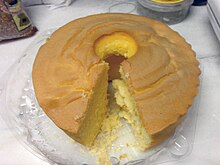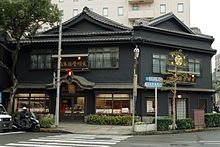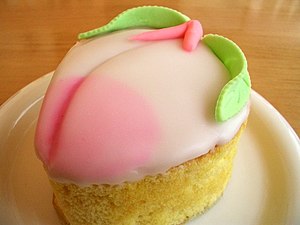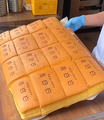|
Castella
Castella (カステラ, kasutera) is a type of Japanese sponge cake and is known for its sweet, moist brioche-style flavour and texture. It is based on cakes introduced to Japan by Portuguese merchants in the 16th century. It was then popularized in the city of Nagasaki, where it is considered a specialty.[1] Despite its foreign origins, it is considered a kind of wagashi, or traditional Japanese confectionery.[2][3][4] To suit the tastes of Japanese people, mizuame syrup was added to the sponge cake to make it more moist, and zarame (coarse sugar) was added to the bottom to give it a coarser texture.[5] Castella is usually baked in square or rectangular molds, then cut and sold in long boxes, with the cake inside being approximately 27 cm (11 in) long. Etymology The word "castella" is derived from the Portuguese Bolo de Castela, meaning "cake from Castile".[6][1] Its closest relative is pão-de-ló, a Portuguese cake. Pão-de-ló can be in turned derived from the French Pain de lof[7] or Gâteau de Savoie.[8] Similar European sponge cakes also reference Spain in their names, such as in Italian: Pan di Spagna, in Portuguese: Pão d’Espanha, in Romanian: Pandișpan, in Bulgarian: пандишпан, in Serbian: патишпањ, in Greek: Παντεσπάνι, and in Turkish: Pandispanya. Castile was a former kingdom of Spain, comprising its north-central provinces, thus these names are quasi-synonymous with "bread from Castile". History In the 16th century, the Portuguese reached Japan and soon started trade and missionary work. Nagasaki was then the only Japanese port open for foreign commerce. This exchange, called the Nanban trade, brought many new things to Japan. The Portuguese introduced things such as guns, tobacco, pumpkins, and cakes baked with wheat flour, eggs, and milk. Castella cakes could be stored for a long time, and so were useful for the sailors who were out on the sea for months. In the Edo period, in part due to the cost of sugar, castella was an expensive dessert to make despite the ingredients sold by the Portuguese. When the Emperor of Japan's envoy was invited, the Tokugawa shogunate presented them with castella cakes.[9] Over the years, the taste changed to suit Japanese palates. VarietiesThere are now many varieties made with ingredients such as powdered green tea, brown sugar, and honey. They may be molded in various shapes; a popular Japanese festival food is baby castella, a bite-sized version. Siberia, castella cake filled with yōkan (sweet bean jelly), was popular in the Meiji era; it had a resurgence since it appeared in the 2013 animated film The Wind Rises, by Hayao Miyazaki.[10] Castella mix is used for the pancakes that are sandwiched together with sweet adzuki bean paste in the confection known as dorayaki.
Taiwanese castellaCastella were first introduced to Taiwan during the age of Taiwan under Japanese rule. In 1968, Ye Yongqing, the owner of a Japanese bakery in Taipei named Nanbanto, partnered with the Japanese company Nagasaki Honpu to establish a castella business.[11] Taiwanese style castella is generally more soufflé-like than the Japanese variety with a custard like center.[12] A speciality of Tamsui is a simple pillow shaped castella cake.[13] Taiwanese style castella has been introduced into Japan.[12] Main manufacturers
See alsoReferences
External linksWikimedia Commons has media related to Castella (food). |
||||||||||||










